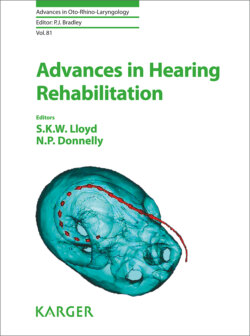Читать книгу Advances in Hearing Rehabilitation - Группа авторов - Страница 51
На сайте Литреса книга снята с продажи.
Bilateral versus Unilateral Fitting in Bilateral Conductive Hearing Loss
ОглавлениеBinaural hearing relies on the separation of inputs to each cochlea, which facilitates interaural time differences for low frequencies and interaural level differences for high frequencies, produced by head-shadow [19]. However, vibrations from one BCHI travel not only to the ipsilateral cochlea but also to the contralateral cochlea. The universal transmission through the skull bone, which is successfully used to benefit patients with SSD, limits the ability of the auditory system to process binaural information potentially due to the interaction of the vibration waveform arriving to each cochlea in its relative phase and amplitude, and it is often used as a reason for unilateral fitting [20]. However, bilateral BCHIs have been shown to have many advantages, both via objective audiological outcomes and subjective measures.
